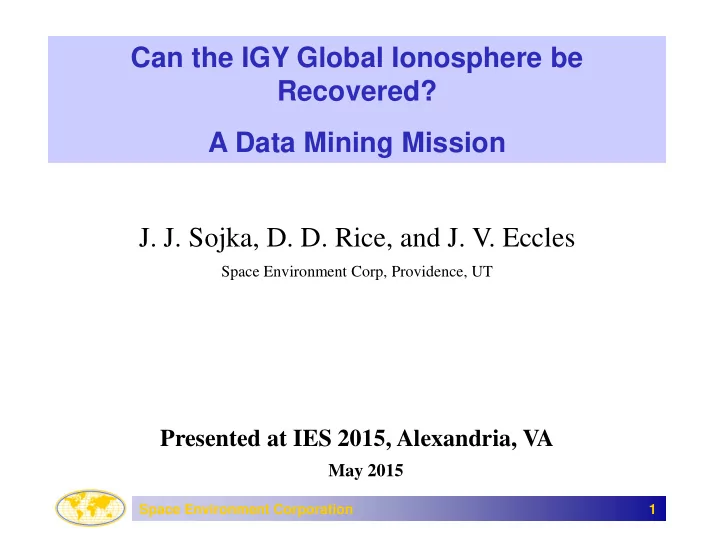

Can the IGY Global Ionosphere be Recovered? A Data Mining Mission J. J. Sojka, D. D. Rice, and J. V. Eccles Space Environment Corp, Providence, UT Presented at IES 2015, Alexandria, VA May 2015 Space Environment Corporation 1
Ionograms and the Global Ionosphere • The International Geophysical Year (IGY) from 1957-58 fielded the most comprehensive set of instrumentation in the modern scientific age; and Sputnik started the Space Age. • A large archive of IGY ionograms on 35mm film still exists in global repositories World Data Centers (WDC). • Most ionograms were recorded at a 15-minute (or better) cadence, but the official analysis is limited to an hourly summary. Hence data-mining for science is very possible. • Modern analysis of the films will allow bottomside electron density profiles (EDPs) on the most comprehensive global scale. Space Environment Corporation 2
Overview • Are enough IGY sites available? • Are the ionograms adequate? • Can ionogram coordinate registration be validated? • Was IGY a scientifically interesting period? • Open E-region Science Questions. • Open F-region Science Questions. Space Environment Corporation 3
IGY Ionosonde Distribution Based on SPIDR • Over 100 ionosondes operated at some point during the IGY. • The map above shows a subset of 76 sites that operated routinely during most of the IGY period. • Hourly hand-scaled values for these sites are available from NGDC SPIDR. • Depending on source as many as 300 ionosondes operated during IGY!? Space Environment Corporation 4
The 35 mm Film Ionogram Archive • The 35mm films are generally stored on movie- style reels • Each reel has 2-3 weeks of ionograms depending on cadence • Frames have timestamps, frequency markers, and virtual height markers Space Environment Corporation 5
Can “Film” Ionograms be Calibrated? • VIRTUAL HEIGHT-true height? • Ionograms with multiple-hop sporadic E may be used to check virtual height calibration • Sporadic E layers provide sharp reflection surfaces between 100- 120 km • Each hop or reflection should be a multiple of the layer virtual height • FREQUENCY? • Using know transmitters • Fort Belvoir (down the road) has well defined 2.5 MHz WWV signal. Space Environment Corporation 6
Was IGY a Scientifically Interesting Period? • Solar activity is summarized by the annual F10.7 index and its standard deviation • Geomagnetic activity is summarized by the annual KpSum • 2 Vertical lines indicate the IGY period, 1957-1958 Space Environment Corporation 7
Sequential and Descending Layers: E-Region Dynamics • E-region dynamics may be seen in the 15-minute cadence ionograms. • Analysis of film ionograms from Ft. Belvoir have shown the presence of descending layers. • These layers may be used to study atmospheric waves and tides. • Note: a few miles to the south is the location of Ft. Belvoir where the NBS developed the ionosondes used extensively in IGY. Space Environment Corporation 8
Electron Density Profiles: F-Region Dynamics • 1951 Ft. Belvoir ionograms extracted from 35mm film with 15 minute cadence. • The digitized ionograms may be analyzed with autoscaling software such as SEC’s ESIR. • Electron density profiles (EDPs) can be generated for suitable ionograms. • EDPs reveal waves and trends that are not obvious from the traditional hourly scaled URSI key parameters. Space Environment Corporation 9
F-Region Dynamics Space Environment Corporation 10
Discussion • Archived IGY data sets contain a large amount of scientific information that has not been extracted. (I estimate 95%) • Analysis with modern models and tools and comparison with more recent data sets may reveal long-term trends and other phenomena. • International effort to recover the IGY Ionosphere: • PHASE I: identify WDC holdings globally and international effort to digitize these ionogram films. • PHASE II: Cal/Val effort to convert films ionograms to digital ionograms. Techniques exist, and better ones can be developed. • PHASE III: Ionogram Inversion to EDPs and global representations of ionospheric dynamics at 15 minute cadence. Techniques exist and better ones can be developed. NEW SCIENCE Space Environment Corporation 11
Recommend
More recommend